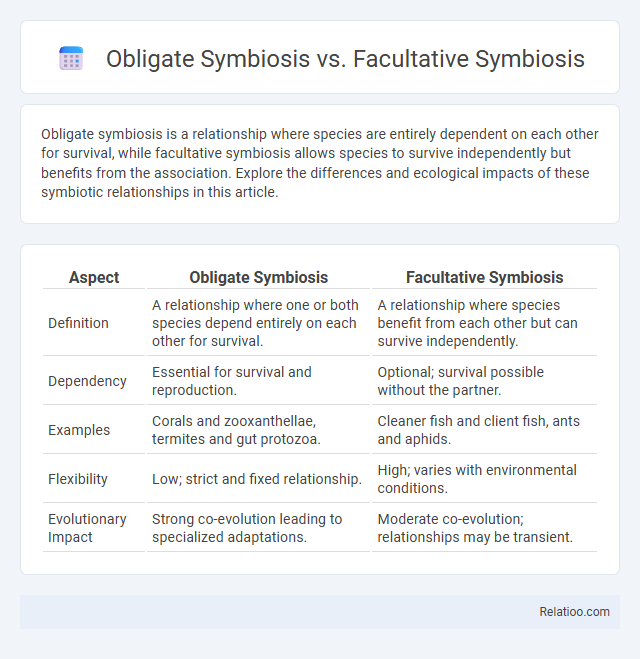Obligate symbiosis is a relationship where species are entirely dependent on each other for survival, while facultative symbiosis allows species to survive independently but benefits from the association. Explore the differences and ecological impacts of these symbiotic relationships in this article.
Table of Comparison
| Aspect | Obligate Symbiosis | Facultative Symbiosis |
|---|---|---|
| Definition | A relationship where one or both species depend entirely on each other for survival. | A relationship where species benefit from each other but can survive independently. |
| Dependency | Essential for survival and reproduction. | Optional; survival possible without the partner. |
| Examples | Corals and zooxanthellae, termites and gut protozoa. | Cleaner fish and client fish, ants and aphids. |
| Flexibility | Low; strict and fixed relationship. | High; varies with environmental conditions. |
| Evolutionary Impact | Strong co-evolution leading to specialized adaptations. | Moderate co-evolution; relationships may be transient. |
Introduction to Symbiosis
Symbiosis is a biological interaction where two different species live closely together, often benefiting one or both organisms involved. Obligate symbiosis refers to relationships essential for the survival of one or both species, such as the partnership between certain bacteria and their host. Facultative symbiosis describes relationships where species can survive independently but may gain advantages when living together, making your understanding of these distinctions crucial for studying ecological interactions.
Defining Obligate Symbiosis
Obligate symbiosis refers to a relationship where two species are so interdependent that one or both cannot survive without the other, exemplified by lichens formed from fungi and algae. Facultative symbiosis involves organisms that can live independently but benefit from close associations, unlike general symbiosis which encompasses any close biological interaction between species. Understanding the distinction between these forms helps clarify how your ecosystem functions and the vital roles species play in mutual survival.
Defining Facultative Symbiosis
Facultative symbiosis refers to a type of symbiotic relationship where both organisms benefit but can survive independently without the association, unlike obligate symbiosis where at least one partner is entirely dependent on the other for survival. This flexible interaction enables organisms to adapt to environmental changes while gaining mutual advantages like nutrient exchange or protection. Your understanding of facultative symbiosis highlights how these relationships vary in dependency levels within the broader concept of symbiosis.
Key Differences Between Obligate and Facultative Symbiosis
Obligate symbiosis requires both organisms to depend entirely on each other for survival, while facultative symbiosis allows either organism to survive independently. In obligate symbiosis, such as the relationship between certain bacteria and host animals, the partners have evolved specialized adaptations making separation lethal. Your understanding of these differences helps clarify how symbiotic relationships influence ecosystem stability and species evolution.
Evolutionary Significance of Symbiotic Relationships
Obligate symbiosis involves species that cannot survive without each other, driving co-evolution and fostering genetic interdependence that enhances survival and adaptation. Facultative symbiosis allows organisms to benefit from associations without being fully dependent, increasing ecological flexibility and promoting evolutionary innovation in changing environments. Your understanding of these symbiotic relationships highlights their evolutionary significance by demonstrating how mutual interactions shape biodiversity, resource utilization, and adaptive strategies over time.
Examples of Obligate Symbiosis
Obligate symbiosis involves species that cannot survive without each other, exemplified by the mutualistic relationship between termites and their gut protozoa, where the protozoa digest cellulose that termites alone cannot process. Another example includes the relationship between the fig tree and fig wasps, where the wasps reproduce only inside fig fruits while pollinating them simultaneously. Your understanding of symbiotic interactions benefits from distinguishing obligate symbiosis, which contrasts with facultative symbiosis where species can live independently yet benefit from association, and general symbiosis encompassing all close biological interactions.
Examples of Facultative Symbiosis
Facultative symbiosis involves relationships where both organisms benefit but can survive independently, such as the interaction between certain ants and aphids, where ants protect aphids in exchange for honeydew. Obligate symbiosis requires at least one organism to depend entirely on the other, seen in the relationship between corals and zooxanthellae algae. Symbiosis broadly describes close and long-term biological interactions, encompassing mutualism, commensalism, and parasitism, with facultative examples highlighting flexible mutual benefits adaptable to environmental conditions.
Ecological Impacts of Symbiotic Interactions
Obligate symbiosis, where species depend entirely on each other for survival, significantly shapes ecosystem stability by enhancing nutrient cycling and energy flow, as seen in coral-zooxanthellae relationships vital for reef health. Facultative symbiosis allows species to benefit from partnerships without full dependence, promoting ecological flexibility and resilience under environmental stress, such as mycorrhizal fungi aiding plant nutrient uptake in varying soil conditions. Symbiotic interactions broadly enhance biodiversity, facilitate resource partitioning, and contribute to habitat complexity, driving ecosystem productivity and resilience to disturbances.
Adaptive Advantages and Challenges
Obligate symbiosis offers adaptive advantages by ensuring survival and resource acquisition through highly specialized interdependence, but it poses challenges such as vulnerability to host or partner extinction. Facultative symbiosis provides flexibility and resilience, allowing partners like You to benefit from interactions when advantageous without strict dependence, yet it risks inconsistent mutual benefits. Symbiosis overall enhances ecological fitness by promoting resource sharing and niche expansion, balanced by challenges of maintaining mutualism and avoiding exploitation.
Future Directions in Symbiosis Research
Future directions in symbiosis research emphasize understanding the molecular mechanisms differentiating obligate symbiosis, where partners depend entirely on each other for survival, from facultative symbiosis, characterized by optional cooperation benefiting individual organisms. Advances in genomic and metabolic profiling will enable you to uncover how variable environmental factors influence symbiotic relationships, revealing adaptive strategies across diverse ecosystems. Integrating multi-omics data and machine learning models is poised to accelerate discoveries of novel symbiotic interactions and their potential applications in biotechnology and sustainable agriculture.

Infographic: Obligate Symbiosis vs Facultative Symbiosis
 relatioo.com
relatioo.com